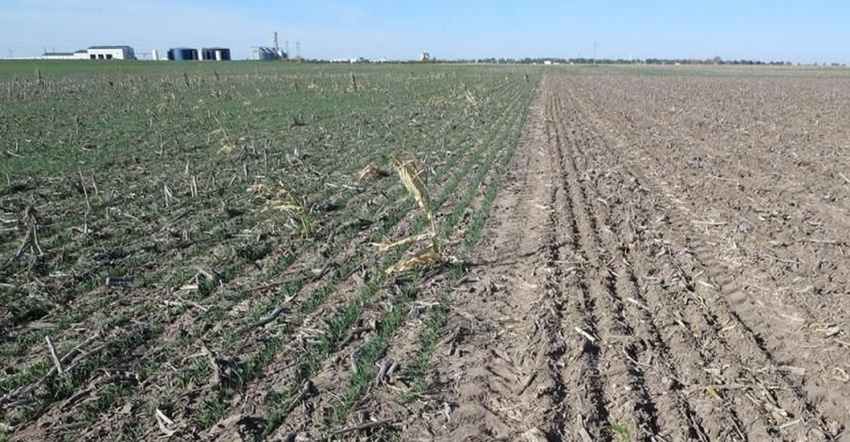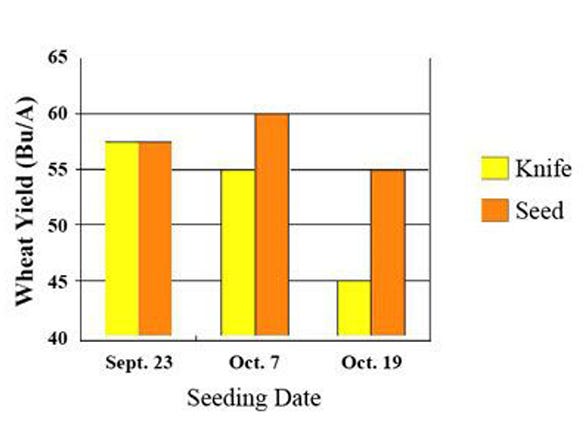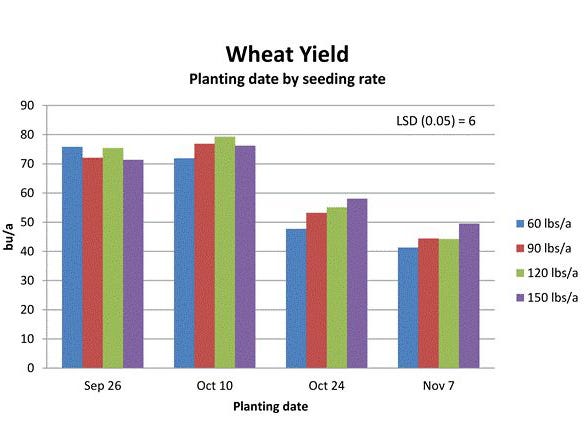October 16, 2017

By Bob Klein
Even when you plan to seed winter wheat at the optimum time, there is always the chance that weather, equipment breakdown or other problems may prevent it. To avoid the risk, many growers seed early, knowing that if they're delayed a little, it will still be near the optimum time. Planting early, however, is usually a bad practice that can lead to lower yields.
Yields from planting date research at the West Central Research and Extension Center at North Platte illustrate the effect of seeding too early. Yields from a Sept. 2 planting date were 2 bushels per acre, Sept. 15 were 27 bushels per acre, and Sept. 25 were 42 bushels per acre.
Rather than seeding too early, seeding later and adjusting practices to compensate for the later timing will have less effect on yield. Figure 2 illustrates how seeding date and starter fertilizer placement affected winter wheat yields in one trial.
Figure 3 illustrates research by Kansas State University on seeding dates in northwest Kansas in the Colby area where the optimum seeding date is Sept. 26. These results show the four-year average yields for each treatment in the study.
The following conclusions can be made from this study:
• Wheat yields were much higher when planted at the optimal time (Sept. 26) or a later date (Oct. 10).
• At the earliest planting date, seeding rate had no effect on grain yield. This is because the plants have plenty of time to tiller, especially at the lower seeding rates.
• At the Oct. 10 planting date, seeding rate did impact yield with the 120 pounds per acre seeding rate, yielding more than the 60-pound-per-acre rate.
 Figure 2. Effect of seeding date on performance of seed and dual placement methods of phosphorus application at three locations and seeding dates.
Figure 2. Effect of seeding date on performance of seed and dual placement methods of phosphorus application at three locations and seeding dates.

Winter wheat seeded late can outyield winter wheat seeded earlier, especially when compared with wheat planted much before the suggested dates. This yield increase can be attributed to reduced disease and insect problems, and the use of extra soil water in the fall.
Recommended practices when seeding late
You can increase your chance of success by taking these steps when seeding wheat late:
• Use narrow row spacings. When seeding after the recommended date, row spacings of 5 to 8 inches are preferred over wider spacings of 10 to 15 inches. If you use a wider spacing, such as with a 15-inch seeder, consider seeding twice, with the second pass at a slight angle to the first. Use one-half the seeding rate each time. This will only work with disk drills; hoe drills move soil and would bury much of the seed from the first pass.
• Increase the seeding rate. Late seeding usually results in less root and tiller development. A general recommendation for rain-fed wheat is to increase the seeding rate 10 to 15 pounds (150,000 to 225,000 seeds) per acre for every week after the suggested seeding date for your area in rain-fed wheat. (The maximum seeding rate for rain-fed wheat is 120 pounds (1,800,000 seeds per acre). Another option would be to limit the seeding rate to no more than twice the seeding rate for the recommended date for your area.
For irrigated wheat, the recommended seeding rate is 90 pounds (1.35 million seeds) per acre if planted at the suggested seeding date. Increase the seeding rate 15 to 20 pounds (225,000 to 300,000 seeds) per acre for every week after the suggested seeding date to a maximum of 180 pounds (2.7 million seeds) per acre.
Also, when no-tilling into row crop stubble, seeding rates can be increased by as much as 50%, even when seeded during the suggested seeding dates. When seeding occurs more than one week after the suggested seeding date, the rate should be 90 to 120 pounds (1.35 million to 1.8 million seeds) per acre for rain-fed. With irrigated wheat, increase the seeding rate the same up to the maximum listed earlier.
• Apply phosphorus with the seed. When seeding wheat late, phosphorus placed with the seed helps improve yield (see Figure 2). The yield increase with the phosphorus placed with the seed is from less soil water used in the fall with the Oct. 7 seeding date, compared to the earlier seeding date of Sept. 23. Use 20 pounds of phosphorus where none is called for by soil tests, and increase other phosphorus rates that are over 20 pounds by 20% for late-seeded winter wheat.

Figure 3. Yield results of study of four seeding rates and four seeding dates conducted by Kansas State University in northwest Kansas where the optimum seeding date is Sept. 26.
Normal superphosphates and ammonium phosphates generally have a negligible effect on wheat stands because of the low salt content of phosphorus fertilizers compared to nitrogen fertilizer; low concentration associated with narrow rows (5 to 12 inches); and the generally high rates of seed used.
The seeding mechanism for applying phosphorus fertilizer with the seed is not critical unless the producer applies additional nitrogen at the same time. Do not apply over 20 pounds of nitrogen per acre with the seed. Also, do not use 12-0-0-26.
If equipment is not available to place fertilizer in the seed furrow, 11-52-0 or 18-46-0 can be mixed with the winter wheat seed. A good mix is important and fertilizer dealers can usually do this for you. One preference is to use 11-52-0 with its lower nitrogen content. With this method, check to see if you are satisfied with the mix by test-drilling on top of the ground so you can observe how well the winter wheat seed and fertilizer are mixed. Be aware that with this method, the fertilizer may cause more wear to the drill. Also, fertilizers can absorb water, so take precautions against this.
• Use certified treated seed. This will increase seeding success. The seed treatments need to thoroughly coat the seeds to give good results and should be applied with quality seed-treating equipment.
Klein is a Nebraska Extension cropping systems specialist in western Nebraska. This report comes from UNL CropWatch.
You May Also Like




